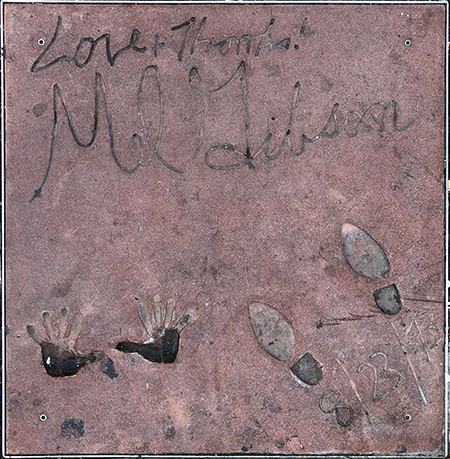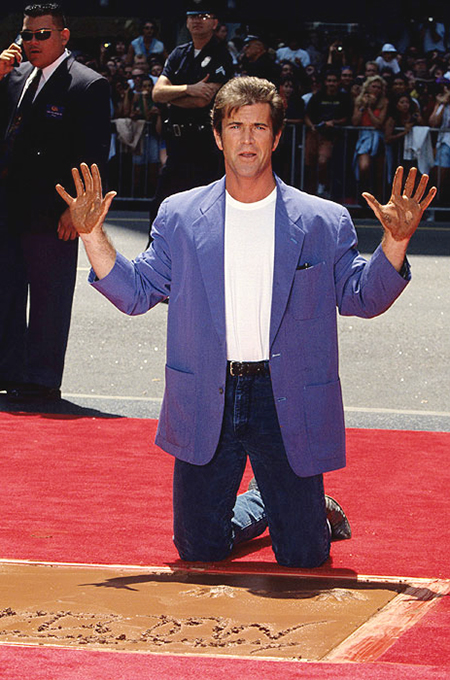 |
 |
|
|
| Mel Gibson |
 |
| Forecourt Ceremony held on Monday, August 23, 1993 |
| |
Born: January 3, 1956, in Peekskill, New York
Age at the time of the ceremony: 37
|
| |
Mel Gibson is the very well-known actor from the Lethal Weapon series, who went on to star in an direct his personal project Braveheart, and bagged a bunch of Oscars the while. Assummed to be Australian, Gibson was actually born in the US. Today, after a patchy time, he seems to be making a comeback of sorts.
Born to Irish-American stock, Gibson's father suffered an injury as a railroad worker; his settlement with the rialroad allowed the large Gibson family to relocate to West Pymble outside of Sydney Australia, when Mel was 12 years old. He was educated by the Christian Brothers in Wahroonga New South Wales.
Trained at the National Institute of Dramatic Art (NIDA) in Sydney, Gibson was a natural attention-getter. Before graduating, he played the title role in Romeo and Juliet with Judy Davis in the other title role. So his interest in Shakespeare and history go waaay back.
He was cast for four
episodes of The Sullivans, aired over the Nine Network in Australia, beginning in November 1977, then appeared in a low-budget surfing movie, Summer City (released in December 1977). He got paid 400 bucks to be in the film. He did a documentary explaining to children how a television studio works on The Hero, aired by the Australian Broadcasting Corporation in March 1979.
Surgeon-turned-director George Miller went to NIDA looking for a "spunky young guy" to play the title role in a little film he was making:
Mad Max (released in April 1979), made Gibson an international star practically overnight. The film made a buttload of money.
Continuing to work in what was called the "Australian New Wave," Gibson starred in a film adaptation of popular Australian author Colleen McCullough's novel Tim (released in July 1979), with Piper Laurie. Australian director Peter Weir included Gibson to star in his war film Gallipoli (released in August 1981), which became another internationally-embraced film from down under.
Both Gibson and Miller made a sequel to Mad Max for Warner Bros. called The Road Warrior (released in December 1981). Now, Hollywood wanted Gibson to headline in films. Director Weir put Gibson in his romantic thriller The Year of Living Dangerously (released in December 1982) for MGM/UA. Gibson played Fletcher Christian to Anthony Hopkins' Captain Bligh in The Bounty (which premiered at the Cannes Film Festival in May 1984).
Gibson's first film shot in the US became The River (released in December 1984), with Sissy Spacek; he earned his first $1 million dollar paycheck for appearing in Mad Max Beyond Thunderdome (released in June 1985), with Tina Turner.
Seasoned Hollywood director Richard Donner put Gibson and Danny Glover in
Lethal Weapon (which played the Chinese in March 1987), which became a huge success. They followed it up quickly (for a sequel, that is) with Lethal Weapn 2 (which played the Chinese in July 1989),
1990 was a busy one for Gibson; he starred with Goldie Hawn in the comedy Bird on a Wire (released in May 1990); starred with Robert Downey, Jr. in Air America (which had its World Premiere at the Chinese in August 1990), and Warner Bros. allowed him to star in a low-budget edited-down version of Hamlet (released in January 1991), with Glenn Close.
Gibson appeared with Glover and Joe Pesci in Lethal Weapon 3 (which played the Chinese in May 1992), becoming his fourth most successful grosser. He made his directing debut with The Man Without a Face (released in August 1993), then teamed with director Richard Donner again for Maverick (released in May 1994), with James Garner and Jodie Foster.
All this led to Gibson's greatest triumph: his telling of the tale of Scottish warrior William Wallace in
Braveheart (released in May 1995). He not only starred in the picture, but he co-produced and directed it, winning Oscars for Best Picture and Best Director. You gotta see it.
Gibson then provided the voice of John Smith in Disney's animated version of Pocahontas (released in June 1995). Continuing with Disney brought us Ransom (released in November 1996), which was another substantial hit as was Conspiracy Theory (released in August 1997), with Julia Roberts. With six years between episodes, Lethal Weaopn 4 (which played the Chinese in July 1998), showed the franchise still had plenty of gas in the tank.
The neo-noir crime picture Payback (which played the Chinese in February 1999), did well, while Gibson did a voice on The Simpsons sending up his Mad Max persona in an episode called "Beyond Blunderdome" aired over the Fox Network in September 1999.
Still absorbed in historical action pictures, Gibson starred in director Roland Emmerich's The Patriot (released in June 2000), with Heath Ledger. Then, for contrast, he co-starred with Helen Hunt in the comedy What Women Want (which played the Chinese in December 2000). Gibson's writing partner Randall Wallace directed him in the Vietnam era story We Were Soldiers (which played the Chinese in March 2002), with Madeline Stowe, which did well also.
Signs (which played the Chinese in August 2002), with Joaquin Phoenix, became the biggest grosser of Gibson's career. He took a small role in and produced a feature-length version of The Signing Detective (premiered at the Sundance Festival in January 2003), with Robert Downey, Jr.
Then came another triumph. Directing on a fairly low budget, and doing the dialog in Latin and Aramaic,
The Passion of the Christ (released in February 2004), with Jim Caviezel, was a brutal look at the Passion story and became a runaway hit. So big, that Disney allowed him to film Apocalypto
(released in December 2006), in the Ancient Maya language. He got by with it.
Then, a July 2006, encounter with law enforcement in Malibu turned into a industry-wide shunning of Gibson for his problems related to alcohol abuse. He began to climb out of the hole with
Edge of Darkness (released in January 2010). Director Jodie Foster took a chance and cast Gibson in the lead of her quirky film The Beaver (released in March 2011), but audiences weren't ready for quirky Gibson.
Get the Gringo (released in March 2012), with Gibson being mistreated in Mexican prisons faired no better, Machete Kills (released in October 2013), with Danny Trejo, met with the usual Grindhouse fate, with Gibson playing the heavy. He also played the bad guy in
The Expendables 3 (released in August 2014), with fellow Forecourt honorees Sylvester Stallone, Harrison Ford and Arnold Schwarzenegger.
His directing of the World War II film
Hacksaw Ridge
(released in November 2016), with Andrew Garfield, was so highly regarded that there was talk of Gibson making a Hollywood comeback; but before that could happen, he would have to co-star in Daddy's Home 2 (released in November 2017), with Will Farrell.
Gibson seems to have fared well in the cop thriller Dragged Across Concrete (released in March 2019) with Vince Vaughn, and has done very well in the Oxford don meets insane man story The Professor and the Madman (released in May 2019) with Sean Penn (as, you know — the madman).
Mel keeps busy — he headlines Force of Nature with Kate Bosworth (released in June 2020), and plays Santa Claus in Fatman with Walton Goggins (released in November 2020). He's heavy in the actioner Dangerous with Scott Eastwood (released in November 2021). He co-starred with Mark Wahlberg in Father Stu (released in April 2022). More stuff is in the pipeline.
|
|
|
|
|
| |
 |
 |
| Mann's Chinese Theatre, Hollywood, California. Mel Gibson Forecourt block. Executed by unknown, Monday, August 23, 1993. 51 x 52 inches. |
 |
 |
 |
| Mann's Chinese Theatre, Hollywood, California. Mel Gibson Forecourt ceremony, Monday, August 23, 1993. Mel Gibson gives the high sign to the crowd. |
|
|